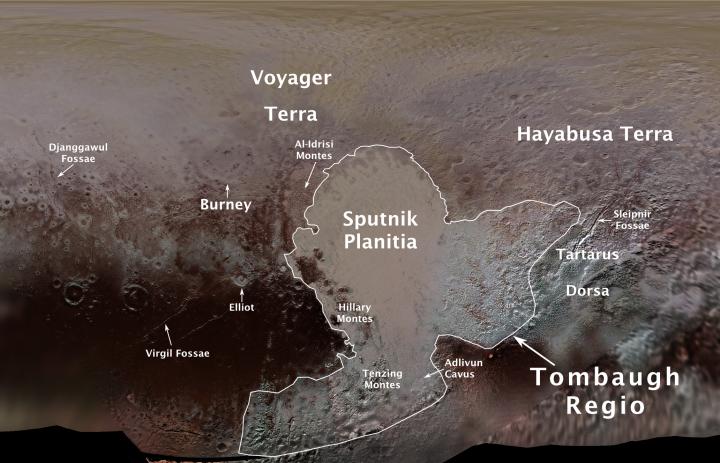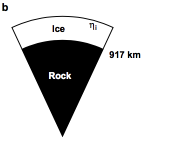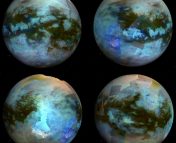Title: Pluto’s Beating Heart Regulates the Atmospheric Circulation: Results From High‐Resolution and Multiyear Numerical Climate Simulations
Authors: T. Bertrand, F. Forget, O. White, B. Schmitt, S. A. Stern, H. A. Weaver, L. A. Young, K. Ennico, C. B. Olkin, and the New Horizons Science Team
First Author’s Institution: Ames Research Center, Space Science Division, National Aeronautics and Space Administration (NASA), Moffett Field, CA, USA
Status: Published in Journal of Geophysical Research: Planets [open access]
Pluto “hearts” us
In 2015, hours before the New Horizons spacecraft made its closest approach to Pluto, the probe took a high resolution photo (Figure 1), sent it back to Earth, and forever changed our view of the mysterious (dwarf) planet.

The stunning heart-shaped region in the image has been officially named “Tombaugh Regio” after Clyde Tombaugh, who discovered Pluto in 1930 (ninety years ago!). Further images showed that the left side of the heart, named “Sputnik Planitia” after the first artificial satellite, is much younger than the other side of the heart. In fact, geological studies suggested that the absence of craters (Figure 2) implied an age of less than 10 million years. Pluto, once believed to be geologically dead, actually has a surprising amount of geological activity, especially in Tombaugh Regio.

The iciest heart in our solar system
Originally thought to be a plateau, Sputnik Planitia is actually a basin, sitting at about 1.9 miles (3 km) below the rest of the terrain. Its low elevation corresponds to a higher pressure and condensation temperature; as a result, this basin holds most of Pluto’s nitrogen ice, which coexists in equilibrium with the nitrogen gas in Pluto’s atmosphere. However, this sheet of nitrogen ice displays some properties that earlier models related to seasonal and astronomical cycles were unable to reproduce, such as the presence of darker plains enriched in dark red material and in methane. A previously unexplored possibility that today’s paper investigates is the role of atmospheric circulation in shaping these mysterious geological features. After all, observations of wind streaks and dunes on Pluto show how Pluto’s surface geology can be affected by its atmospheric dynamics.
Using the New Horizons topography data and an updated high-resolution version of a 3D global climate model developed at the Laboratoire de Météorologie Dynamique, the authors of today’s paper simulate the cycle of nitrogen and methane over different timescales, as well as Pluto’s weather and winds. These essentially cutting-edge weather forecast simulations help understand how the observed distribution of ices on Pluto’s surface came to be.
Cold, but not dead—this heart beats
The work shows that there is an atmospheric current that flows counterclockwise over Sputnik Planitia (Figure 3). This wind is caused by the warming of some nitrogen ice into vapor during the day, and then the vapor condensing back into ice at night—a cycle akin to a heartbeat, where the nitrogen ice sheet in Sputnik Planitia is Pluto’s heart, circulating nitrogen winds across Pluto. The simulations showed the same circulation patterns even with varying distributions of nitrogen ice.

These winds appear to be moving in the opposite direction (westward) of Pluto’s rotation (eastward), in a process called “retrorotation”. It seems that these retrograde winds dominate the atmospheric circulation on Pluto during most of the year. Some of these westward winds blow close enough to the surface to transport heat, ice grains, and other small particles—such as haze particles, which could darken and erode ice—and explain the dark streaks and plains just west of Sputnik Planitia.
While it may seem straightforward that Pluto’s winds affect its landscape, Pluto’s atmosphere is about 100,000 times thinner than Earth’s, making it surprising that such impactful winds can originate in such a thin atmosphere. These simulations showed the importance of Pluto’s winds on affecting the observed color asymmetry of the plains in Sputnik Planitia. However, there is still work to be done. One exciting future possibility is that these winds might be able to explain the skyscraper-sized landforms made of methane ice found near Pluto’s equator (its “bladed terrain). All the same, it is exciting that one flyby was able to reveal such complex and active geology on our solar system’s most beloved dwarf planet!




